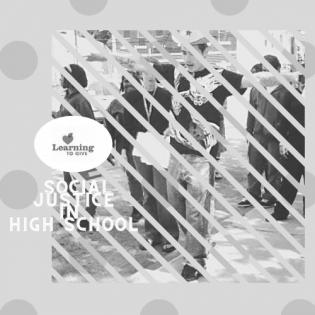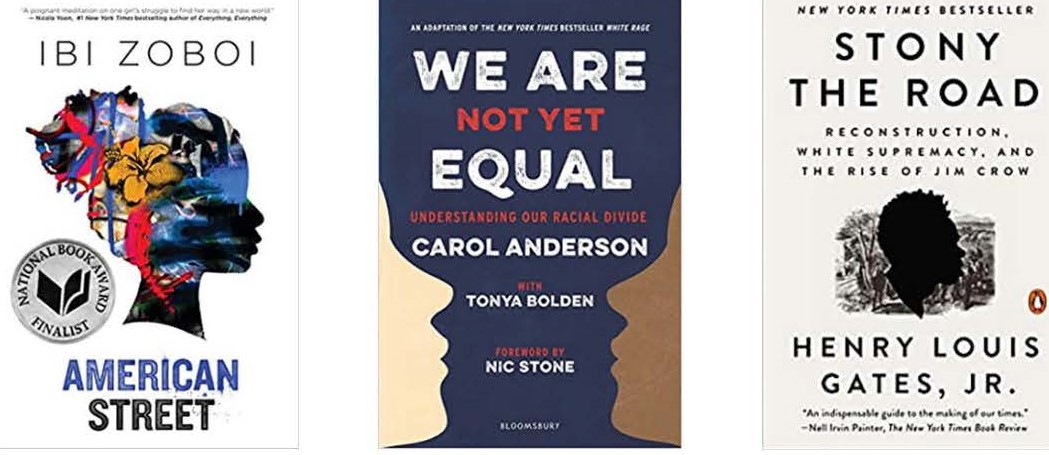Teaching Social Justice in High School
Resource Guide by Anthony Salciccioli
Introduction
This resource guide includes video, literature guides, activities, and lessons that may be used in order or selectively. The discussions and lessons are intended to empower youth voice and guide them toward a service project of capturing someone's social justice story through an audio recording and sharing it with others.
Part I: Personal Connection in Community
Classrooms are communities. We share space and goals and build connections, expectations, and kindness so we can work together effectively for the benefit of all. Building a caring community begins by tapping into empathy and social responsibility to capture hearts and minds.- Share daily hellos and reflections and exit tickets.
- Pose different reflection/discussion prompts and ask for creative responses (poem, song, drawing, video).
- Discuss and decide on group agreements about how you want to be together respecting different viewpoints.
- Set an intention for respectful meetings with these ideas.
Part II: Definitions
Philanthropy
Philanthropy is the practice of "giving our time, talent, or treasure for the common good." Forwarding social justice is a form of philanthropy, a way people give their time and talent for the common good. The U.S. was formed by social action, and our founding documents assure our right to speak our truth for the good of the country.
Examples of social justice philanthropy:
- The Civil Rights Movement was a pivotal time in U.S. history in which people used their voices and nonviolence to assure social justice for all.
- The Black Lives Matter movement is a social justice movement of voices in unison for equity and social justice.
Social Justice
Social justice is the understanding that everyone deserves equal economic, political and social rights and opportunities. This video defines social justice, quotes the First Amendment related to social justice, gives examples of different groups that experience injustice, and analyzes what we control and influence as we work to advance social justice.
Nonviolence
Looking for ways to take action? This resource from the Albert Einstein Institution lists 198 Methods of Nonviolent Action that anyone can reference for ideas of ways to take voluntary action for the common good.
Reflection Questions: As you scan the 198 Methods of Nonviolent Action, reflect on these questions:
- Which of these methods do you recognize in historical stories of protest?
- Which three methods are things youth can do without permission?
- Which methods would you like to learn more about?
Part III: Connect Interests to Action
Explore Youth Passions
Map Your Heartbreak is a simple activity for individual or group settings to explore what we care about and what next steps we can take (also effective online as a synchronous or asynchronous activity).
The full directions are in the link below. This video gives an example so it may be used at home. This is also a great family activity!
You may keep your instructions broad, such as, "What is something you are passionate about?" Or you may narrow the discussion to a topic, such as "What are you passionate about related to the pandemic?" Or ".... related to equity?" Or "... related to elderly people in the retirement home next door?"
Match Interest to Community
As you identify what you care about, this video illustrates how to connect Interests to Needs in the Community.
Part IV: Learn More
Begin with Books
Read one or all of these books. Each has a literature guide to spark discussion and connection to the reading.
- We Are Not Yet Equal Literature Guide
- Stony the Road Literature Guide
- American Street Literature Guide
- The Undefeated Literature Guide
- More books: The Conscious Kid
Understanding Roots and Effects
This group activity may be completed at home or in a remote setting. After selecting an area of interest, brainstorm root causes and effects and conduct research to identify experts who can teach you more about the issue.
Explore Issue Areas
These toolkits provide background information, project ideas, and suggestions for community connections.
Part V: Take Action
Spoken Word Poetry as Medium for Social Justice
This Using Spoken Word for Justice mini-course introduces spoken word poetry as an interactive literary tool particularly suited to promote social justice. This guides participants from the introduction and powerful examples to practice and performance.
A Place in History
All the history we know comes from stories. Each story is set in a time and from a perspective. Your story - what you experience, think, learn, and feel - is a part of history. The culmination of this resource is to tell your story or the story of someone in your community - a story of social justice or of the pandemic.
In this resource, we present many stories and encourage listening with openness and generosity to get a full picture of diverse perspectives.
Capture Stories of the Pandemic
This ten-minute video gives an overview of creating a project about our place in history from the perspective of the pandemic. Before viewing, reflect on the following:
- What are the positive and negative effects of the pandemic and the related public demonstrations?
- When and why did your awareness change? What new civic responsibility are you aware of?
- How did the experience or events change you? How did it change the people around you?
- Who can you interview to learn more?
- What is civic engagement? What is the role of voting?
Your story matters. The stories of others matter.
Oral History Project
For this activity, youth create their own oral history recording by interviewing an individual who they consider a generous leader. Youth will glean lessons from the interview and create and preserve a historical record of a story that is worthwhile knowing. Follow the directions in the Oral History Project link.
Watch the following StoryCorps video capturing the story of an influential person in the interviewer's life. Or this audio of a granddaughter interviewing her grandfather.
Now follow the Oral History project directions to capture a story of someone you respect or a story you want to share of an exceptional person.


